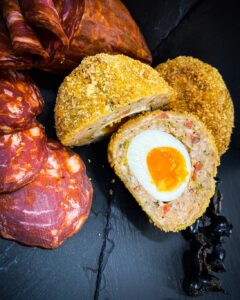 Alongside Cheddar, Stilton is one of the UK’s most famous cheeses. But unlike Cheddar its origins are steeped in mystery and until as late as 2009 it was universally accepted that it was never actually produced in the village of Stilton but took its name from being sold in the village. The cheese was sold from The Bell Inn which was a resting point for weary travellers on their way to and from London along the Great North Road. Its landlord, Cooper Thornhill, became an entrepreneur selling the cheese not just to travellers but into London itself and as demand for the cheese grew Thornhill began seeking new sources from neighbouring Leicestershire. It is believed that this is where the myth of Stilton originating from this area began. However extensive research uncovered convincing evidence of a cheese made in Stilton in the early eighteenth century.
Alongside Cheddar, Stilton is one of the UK’s most famous cheeses. But unlike Cheddar its origins are steeped in mystery and until as late as 2009 it was universally accepted that it was never actually produced in the village of Stilton but took its name from being sold in the village. The cheese was sold from The Bell Inn which was a resting point for weary travellers on their way to and from London along the Great North Road. Its landlord, Cooper Thornhill, became an entrepreneur selling the cheese not just to travellers but into London itself and as demand for the cheese grew Thornhill began seeking new sources from neighbouring Leicestershire. It is believed that this is where the myth of Stilton originating from this area began. However extensive research uncovered convincing evidence of a cheese made in Stilton in the early eighteenth century.
Today Stilton has been given Protected Designation of Origin status which means that it can only be produced in the counties of Derbyshire, Nottinghamshire and Leicestershire by only six individual dairies: Colston Bassett, Cropwell Bishop, Hartington Creamery, Long Clawson, Tuxford & Tebbutt Creamery and Websters. In order to call their cheese Blue Stilton they must meet certain criteria; it must be made using local, pasteurised milk, must form its own crust and must have blue veining radiating from the centre of the cheese.
We are lucky enough to stock Stilton from both the Long Clawson Dairy and Tuxford & Tebbutt Creamery. Made to a traditional recipe dating back to 1780 the Tuxford & Tebbutt brand is a guarantee of award-winning Blue Stilton with delicious rich and creamy flavours and a piquant finish. Long Clawson Dairy was established in 1911 to ensure that the cheese and the methods used to make it would survive for generations to come. It is a bold, expressive cheese with rich and tangy flavours.
This rich and unique history results in a fantastic cheese. It is no wonder that it has stood the test of time and is still considered the ‘King of English Cheeses’.


